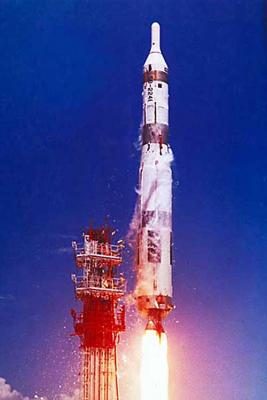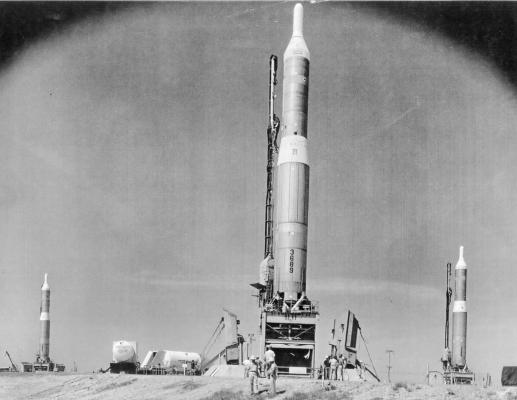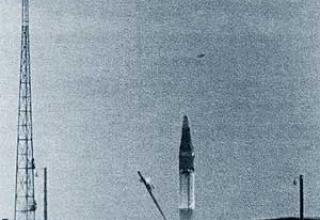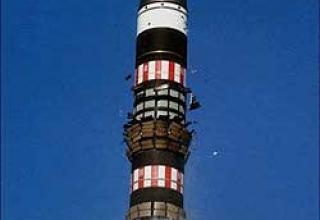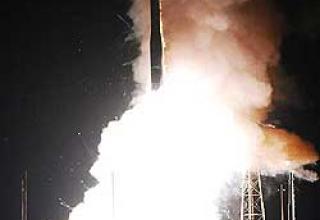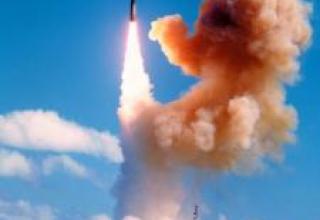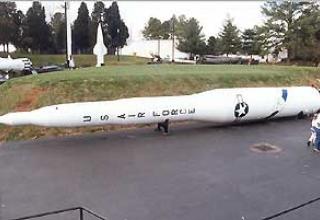The Titan-1 has had its pedigree since January 1955, when the U.S. Air Force decided to "duplicate" the then first U.S. Atlas ICBM by choosing another group of major contractors, as well as by using a different set of basic design solutions - primarily through the use of a sequential connection of stages, as well as by using a standard type of missile design (with a power pack). The study of this concept, however, began in July 1954 under the terms of the ICBM Scientific Advisory Committee. This concept as a whole was approved by the U.S. Air Force General Headquarters in April 1955, and in October 1955, after considering a number of options, the contractor for the development of the missile itself and a number of its systems was named "Glenn L. Martin Aircraft Company" (later "Martin Marietta"). It was also named the main contractor for the project as a whole. Then the missile received its own name "Titan" and the designation SM-68A (in 1962, after changing the designation system in the U.S. Air Force missile received the designation HGM-25A). The development of the engines of both marching stages was entrusted to Aerojet General Corporation. The radio-inertial guidance system was developed by Bell Telephone Laboratories and Remington Rand UNIVAC. The development of the combat unit was entrusted to the firm AVCO. The entire program was developed within the framework of the WS-107A-2 weapon system. In October 1957, after the launch of the first Sputnik by the Soviet Union, it was decided to accelerate the deployment of 4 squadrons of ICBM data, but quite quickly this number was increased to 12. However, in 1960, after the start of research and development work on the Titan-2 ICBM (created by almost the same group of contractors using the Titan-1 ICBM R&D facility), a decision was made to reduce the number of Titan-1 ICBM squadrons to six.
The first launch of the new ICBM took place in February 1959 (Patrick Airbase, Florida), with the second march stage filled with water instead of fuel components and an inseparable mock-up was used instead of the standard head end. The first step separation (the second step was still a mock-up) was performed during the fourth launch. The first successful launch with a standard second stage and a telemetry capsule instead of a HF was carried out in February 1960. The first successful launch of the rocket with a conventional second stage and a capsule with telemetry equipment instead of a HT was carried out in August of the same year. December 2, 1960 was activated the first squadron, which was to put on combat duty new ICBMs. A day later, from the Vandenberg air base, using a prototype of a stationary combat missile system, the first attempt was made to launch the Titan-1 ICBM from the West Coast (unsuccessful, Sputnik was destroyed by an explosion, later did not recover). The first successful launch of a new ICBM using a stationary missile system was made from Vandenberg Air Base in May 1961. The first squadron, which had in service new missiles (9 ICBM), began to carry out combat duty in April 1962 (air base Lauri, Colorado). By October 1962, squadrons at Lowry Air Force Base (9 ICBMs, making this the largest air base with 18 ICBMs), Mountain Home (Idaho, 9 ICBMs), Beale (California, 9 ICBMs), Larson (Washington, DC, 9 ICBMs), Ellsworth (South Dakota, 9 ICBMs) were also on duty on new military equipment. In addition, at Vandenberg Air Force Base (California) there was one deployed with this type of ICBM (3 SLBMs), but U.S. sources claim that these SLBMs were not used for combat duty, which is highly questionable.
The Titan-1 ICBMs, like other first-generation ICBMs, were not safe to handle - in different years (during launch attempts and during refueling procedures) the explosions destroyed two launch positions (START). One of them was later recovered.
Successful testing and deployment of second-generation ICBMs led to the approval of the Air Force Headquarters as early as May 1963 to retire a number of first-generation ICBMs (including the Titan-1) between January 1965 and December 1968. Later it was decided to expedite the process - in 1964, Defense Minister McNamara released a plan (known as "Project Added Effort"), according to which most of the first-generation ICBMs (except Atlas-F) were off duty by December 1965. In November of the same year, the "Project Added Effort" plan was extended to all first-generation ICBMs, whose decommissioning was further accelerated by the decision to decommission the last first-generation ICBM no later than the end of June 1965. The first Titan-1 ICBM was decommissioned in January 1965, and in March of the same year was the last launch of this ICBM. The last Titan-1 ICBM was decommissioned in April 1965, while the last squadron of these ICBMs (Lauri Air Base, Colorado) was deactivated in June of the same year. The short history of the Titan-1 ICBM came to an end - the missiles were on active duty for only three years. All deactivated missiles were deployed at Miro Loma Aviation Station (California).
The Titan-1 ICBM was not used (as opposed to Atlas or Titan-2 ICBMs, for example) as an LV or for research launches - a year after its deactivation, in April 1966, all the stowed missiles were written off and their individual parts were later used for various experiments on Earth. A total of 155 missiles were produced, of which 70 were used in launches (17 launches failed). While on active duty, the Titan-1 ICBM was used for a number of test launches, primarily to test a number of systems of the Titan-2 advanced ICBM - an inertial navigation system, an anti-missile defense system, and a gas-dynamic launch of a heavy liquid-propellant ICBM. "Titan-1 was also used in the program for testing early American missile defense systems.
Composition:
The Titan-1 intercontinental ballistic missile was structurally a two-stage missile (see diagram), whose stages were connected in a longitudinal pattern. The fuel tanks of both stages of the missile had a supporting structure and were welded from panels made of special, lightweight and high-strength aluminum alloy 2014 with copper admixture. Tank panels made of this alloy were manufactured using unique for those times forming equipment and presses. The received blanks were chemically milled and the panels were assembled by tungsten electrode welding in inert gas.
The first stage was equipped with a rocket engine LR87-AJ-1, which had two combustion chambers made of special steel with independent supply of their fuel components. As a fuel on both stages of the rocket used a special rocket kerosene RP-1, as an oxidizer - liquid oxygen. The combustion chambers were fixed on a special steel frame. To control the rocket through the channels of pitch and yaw on the section of the 1st stage, combustion chambers could deflect in their hangers at angles up to 5°. No tilt channel control was performed in the 1st stage operation area. Each combustion chamber is equipped with an independent turbo-pump unit (TNA). The TNA includes fuel and oxidizer pumps, a gearbox and two balanced turbines. The first stage engine was switched off by triggering a special sensor that recorded the pressure drop in the combustion chambers, after which the control system generated a signal to switch on the second stage power plant. Separation of stages was carried out according to the so-called "cold" scheme, i.e. when the engine of the second stage is not running. The 2nd stage was driven from the first stage to a distance of 4.5 m by means of 2 small thrust RDTTs, which also provided fuel sludge.
The second stage was equipped with a single-chamber rocket engine LR91-AJ-1 on a special steel frame. To control the missile through the channels of pitch and yaw on the 2nd stage, the combustion chamber could deflect in its suspension to an angle of 3°. The tilt channel control in the 2nd stage operation area was performed with the help of four special nozzles operating on gas generator gas. Switching off the second stage power plant was carried out by triggering a special sensor that recorded the pressure drop in the combustion chamber of the marching engine, after which the control system generated a signal to turn on the power plant accurate correction of trajectory.
The precision trajectory correction propulsion system consisted of two liquid engines, which were started simultaneously for the final height and speed corrections. After the end of their work (operating time up to 50 sec), the pyrolocks holding the head end were triggered. Next, the block of withdrawal motors was switched on, and also KSP PRO was triggered. The citation motor unit consisted of two solid propellant motors that were started in series. They were used to move the stage away from the HC.
The missile was equipped with a monoblock thermonuclear warhead, which consisted of an Mk4 combat unit with ablation-type thermal protection and a W-38 combat unit with a power of 4.5 Mt. To increase the probability of overcoming the ABM of a probable enemy, the missile was equipped with an ABM system consisting of light inflatable false targets. For the period of the early 1960s, such a BMD SLCM was a rather serious achievement. The radio-inertial control system provided the CWO no more than 2.2 km.
The launch complex for Titan-1 ICBMs was a real underground city with no analogues to this day. At one end of the territory there were three 49*13.5 m each, made of heavy reinforced concrete with thickness from 0.6 to 0.9 m. The structure of the mine (see diagram) withstood excess pressure in the front of a thermonuclear explosion shock wave up to 10.5 kgf/cm2 (for DBKs deployed at Vandenberg Airbase; for complexes deployed in position areas, this value was increased to 14 kgf/cm2).
Immediately prior to launch, the rocket, already loaded, was lifted to the surface from the silo by a special elevator, which reduced its vulnerability to a surprise attack by the enemy. The mine was closed with a pair of reinforced concrete doors weighing 125 tonnes each. Next to each mine underground (at a depth of 5.2 to 7.3 m) there were rooms for storage of fuel components as well as rooms for additional equipment.
In a few tens of meters from these structures underground (at a depth of 3 to 5.2 meters) there was a command post and an additional power station (where there were diesel generators and storage batteries), both of which had hemispherical shape. The size of the control room was 30.5*12.2 m, the size of the auxiliary power station - 38.7*18.3 m. In the middle between these structures there was an entrance to the complex (with a roof at ground level), size 22*11.6 m.
At the opposite end of the complex there were two shafts with control and guidance system antennas for ICBMs. The size of each mine was 20.7*11.6 m. Before starting, the covers of these shafts were opened and the antennas were extended to the surface. The distance between the most distant ICBMs and the mine with the antennas did not exceed 400 m. Steel tunnels with a total length of about 760 m were built between all underground structures. They had a diameter of 2.7 m and were laid 12 m underground. The staff of one DBK consisted of 10 people.
Characteristics:
| Range of fire, km | 11 300 |
| Length assembled, m | 29,9 |
| Diameter of the first stage, m | 3,05 |
| The length of the first step, m | 16 |
| Diameter of the second stage, m | 2,26 |
| Length of the second stage (without adapter for HF and HC), m | 9,8 |
| Launch mass of the rocket, t | 105,2 |
| Gross mass of stage 1, t | 76,2 |
| Gross mass of 2nd stage, t | 27,2 |
| The mass of the empty 1st stage, t. | 4 |
| The mass of the empty 2st stage, t. | 1,73 |
| Mass of combat equipment (HC+BMD), t | 1,8 |
| Stage 1 traction at sea level, kN | 1 296 |
| 1st stage traction in vacuum, kN | 1 468 |
| Specific impulse of the 1st stage at sea level, s | 256 |
| Specific pulse of the 1st stage in a vacuum, s | 290 |
| Stage 1 operating time, s | 138 |
| 2nd stage traction in vacuum, kN | 356 |
| Specific 2nd stage pulse in a vacuum, s | 308 |
| Step 2 operating time, with | 225 |
| Apogee height of the GC flight path, km | 1 300 |
| HF power, Mt. | 1,45 |
| KVO HC, km | 2,2 |
Testing:
Testing of the complex began on April 21, 1995 at White Sands Range and continued with varying success until 1999. Only the ninth launch, on March 29, 1999, demonstrated the performance of the complex as a whole. During this flight, despite the failure of the interceptor's spatial orientation system for 23 seconds of flight and the termination of telemetry data reception for 58 seconds, the interceptor passed in close proximity to the Hera target missile.
During the tenth test launch on June 10, 1999, for the first time, a target simulating a SKAD missile was successfully intercepted and the technical feasibility of such an intercept was confirmed.
On 2 August 1999, during the eleventh test, a target simulating a detachable SCAD-type ballistic missile head in the upper atmosphere was intercepted.
Sources:
- To defend and deter: the legacy of the United States Cold War missile program / J.C. Lonnquest and D.F. Winkler. USACERL, 1997.
- From Snark to Peacekeeper: a pictorial history of Strategic Air Command missiles / SAC HQ Office of the Historian, 1990.
- Alert operations and the Strategic Air Command, 1957-1991 / SAC HQ Office of the Historian, 1991.
- SAC Missile Chronology 1939-1988 / by Office of the Historian HQ SAC. OH HQ SAC, Offut AFB, NE, 1990.
- "Titan-I" and "Titan-II" site activation manual / Martin Co. Denver, 1960.
- SAC and the Alert Program: A Brief History / by Office of the Historian HQ SAC. OH HQ SAC, Offut AFB, NE, 1988.
- US Strategic and Defensive missile systems 1950-2004 / M.A. Berhow and C. Taylor. Osprey Publishing Ltd., 2005.
- А.А. Шумилин «Авиационно-космические системы США», 2005 Москва, «Вече».
- www.strategic-air-command.com
- www.astronautix.com
- www.nuclearweaponarchive.com
